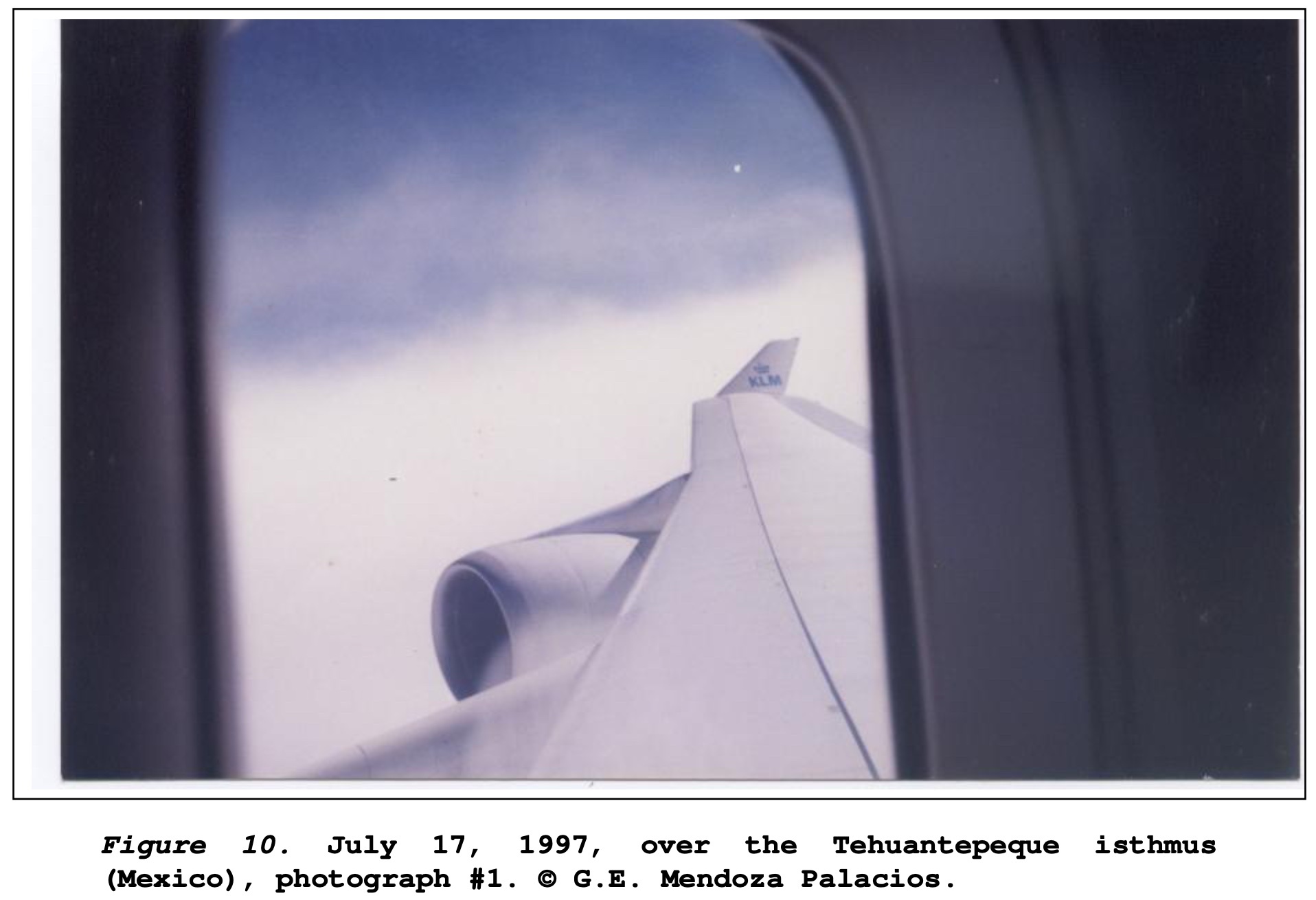
10.07.2023
In der UFO-Forschung haben wir es ja mit vielen Varianten der beobachteten Objekte zu tun und mit Einführung des UAP Begriffes sind in den letzten Monaten die Diskussion um Sphären aufgekommen. Die Aufnahmen dieser kugelförmigen Objekte werden nun als großes Geheimnis in der UFO-Szene gehandelt auch wenn diese Aufnahmen sehr nach herkömmlichen Flugobjekten wie Ballons aussehen.
In diesem Zusammenhang haben wir eine interessante Studie von Vicente-Juan Ballester Olmos1 and Martin Shough zur Kenntnis bekommen und welche wir mit freundlicher Erlaubnis hier nachfolgend veröffentlichen können. Nach dem Original in Englisch gibt es davon eine Deutsch-Übersetzung welche die ersten Ergebnisse nach vorhandenen Spähren-Fälle beinhaltet.
H.Köhler/CENAP
+++
SPHERES IN AIRBORNE UAP IMAGERY
ABSTRACT
Objects or lights of possibly spherical appearance photographed and filmed from aircraft in the air have been sought from a massive databank on UAP reports recorded on film. Only 7 events have been considered for examination and these have been analyzed to the limit of the available information. The average level of information remains low, in spite of the authors’ attempts to improve it, but 4 events allow reasonable mundane explanations. The remaining 3 are hardly evaluable and lack strangeness. In general, all images are highly ambiguous. The authors recommend that steps need to be taken to increase the professionalism of UAP inquiry.
+++
SPHÄREN IN BILDERN VON UAP-BILDERN IN DER LUFT
ABSTRAKT
Objekte oder Lichter mit möglicherweise kugelförmigem Aussehen, die von Flugzeugen in der Luft fotografiert und gefilmt wurden, wurden in einer riesigen Datenbank mit auf Film aufgezeichneten UAP-Berichten gesucht. Für die Untersuchung wurden nur 7 Ereignisse berücksichtigt und diese wurden bis zur Grenze der verfügbaren Informationen analysiert. Der durchschnittliche Informationsstand bleibt trotz der Versuche der Autoren, ihn zu verbessern, niedrig, aber vier Ereignisse ermöglichen vernünftige, profane Erklärungen. Die restlichen 3 sind kaum bewertbar und mangelt es an Fremdartigkeit. Generell sind alle Bilder höchst mehrdeutig. Die Autoren empfehlen, dass Schritte unternommen werden müssen, um die Professionalität der UAP-Untersuchung zu erhöhen.
+++
Introduction
FOTOCAT is presently the largest data warehouse for Unidentified Aerial Phenomenon (UAP) reports in the world where photograph, motion picture or video imagery has been obtained, with over 12,000 entries collected up to the catalogue’s cut- off date of December 31, 2005 (http://fotocat.blogspot.com/).
The tally for airborne cases shows 254 entries, which have been examined for the purpose of NARCAP’s Project Sphere. The following elimination process described in Table 1 was applied to the archive to determine how many cases are finally retained for analysis:

Table 1. Selection process followed from database.
In principle, barely 7 reports fulfill the requirements of being spherical UAPs photographed or filmed from the air for which the compiler (first author) has got an image of the object.
It is not guaranteed that these 7 events have been properly documented or that they represent true examples of unidentifiable phenomena. Rather they are presented to illustrate the type of photographic report UAP researchers
receive from the public, or those which circulate in this medium.
Comments on the exclusion criteria follow. Cases that have been solved in a conventional manner comprise as many as 113 or 44% of the sample. Images in photographic emulsions, video recordings or digital media which were invisible to the eye of the photographer were 17 (7%). Experience indicates a high probability for virtual, immaterial objects due to photographic failure, lens flares, etc. There are 14 photographs (6%) dating back to the Second World War, but these do not seem to stand as suitable enough for this paper. Lack of proper documentation, including absence of an image in the first author’s archives, amount to 53 instances, or 21%. Within this set of reports several more potential 'sphere' events might be found in the future, when and if the occurrences are better investigated and documented. Finally, there exist 50 reports showing UAPs of shapes other than a sphere, or 20% of the total.
If readers of the present report believe they have information about any incident depicting any image of sphere- shaped UAPs, the authors would appreciate being notified.
Data Overview
Unlike many typical UAP sighting reports, photographic events have been poorly investigated. In some cases, the original information is scarce; the sources are difficult to follow-up; there is a marked absence of evaluation and
technical analysis. It seems that UAP aficionados are content to publish a photograph in the literature (or, recently, just in the public internet) as though this should suffice to prove that an anomalous phenomenon exists.
Table 2 lists the 7 events saved for this presentation (dates are day-month-year).

Table 2. List of cases selected for analysis.
For the two episodes of the 1970s the picture format is a
slide, for two others the original format is a print from an analog camera, and in the other three cases what we have are digital images taken directly from online sources. The internet medium, coupled with the fact that images are often received at nth hand from their originator, reduces their credibility dramatically. In the considered examples, even the full name of the person who allegedly saw the anomalistic object in airspace and captured it on film is not known in 2 out of 7, and in one more instance there is reasonable doubt about it.
Reports come from two continents: 2 cases from Europe (Spain and Ireland) and 5 from America (2 North America and 3 Central and South America). Only one country (United States of America) contributes two cases, the remaining five belong to different nations.
Catalogue of Cases
Case #1
Date: March 30, 1972 Time: 09:00 Location: Pyrenees Mountains (Spain) Cameraperson: Tom Pollack Mode: Slide
Guillermo G. Roncoroni was one of the best ever UAP researchers in Argentina, one of the few and certainly the first to apply electronic computers to UAP investigation in that country, not for nothing was he employed by IBM in Buenos Aires. The first author developed a good working relationship with him from 1978. Roncoroni died in 1999.
One of the specialties of Roncoroni was the field of UAP photography, having written an interesting book on the subject (1). When he died, his photographic files (normally, slides) were transferred to noted Argentinean researcher and journalist Alejandro Agostinelli, who several years ago was generous enough to donate Roncoroni ́s collection of UAP slides to the FOTOCAT Project.
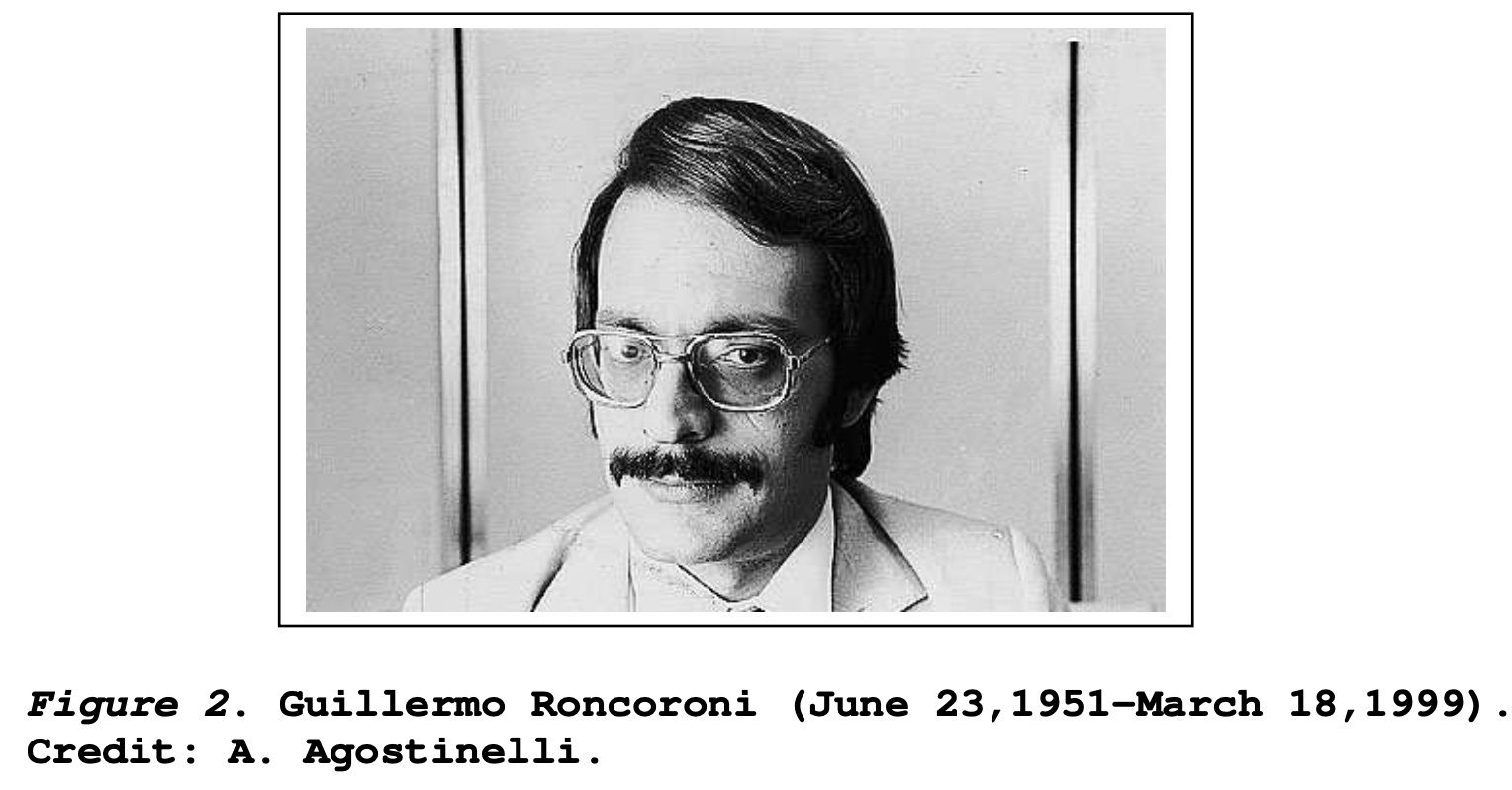
One of these transparencies was the one we study now. The only information to document the image is what is found in Roncoroni’s “UFO Slides Catalogue”, which for every entry it contains the date, the time, the location and the photographer’s name. Nothing else.
The target here is a roughly round mark pictured from an aircraft flying over the Pyrenees, a large mountain range that separates France from Spain. The problem “object” (darker than the background blue sky) can be found in the portrait around the “one o’clock” position (30o). Roncoroni’s catalogue does note Spain as the country over flown at the time of the photography.
By rendering the target image in the slide at high contrast it reveals to be irregular in shape.
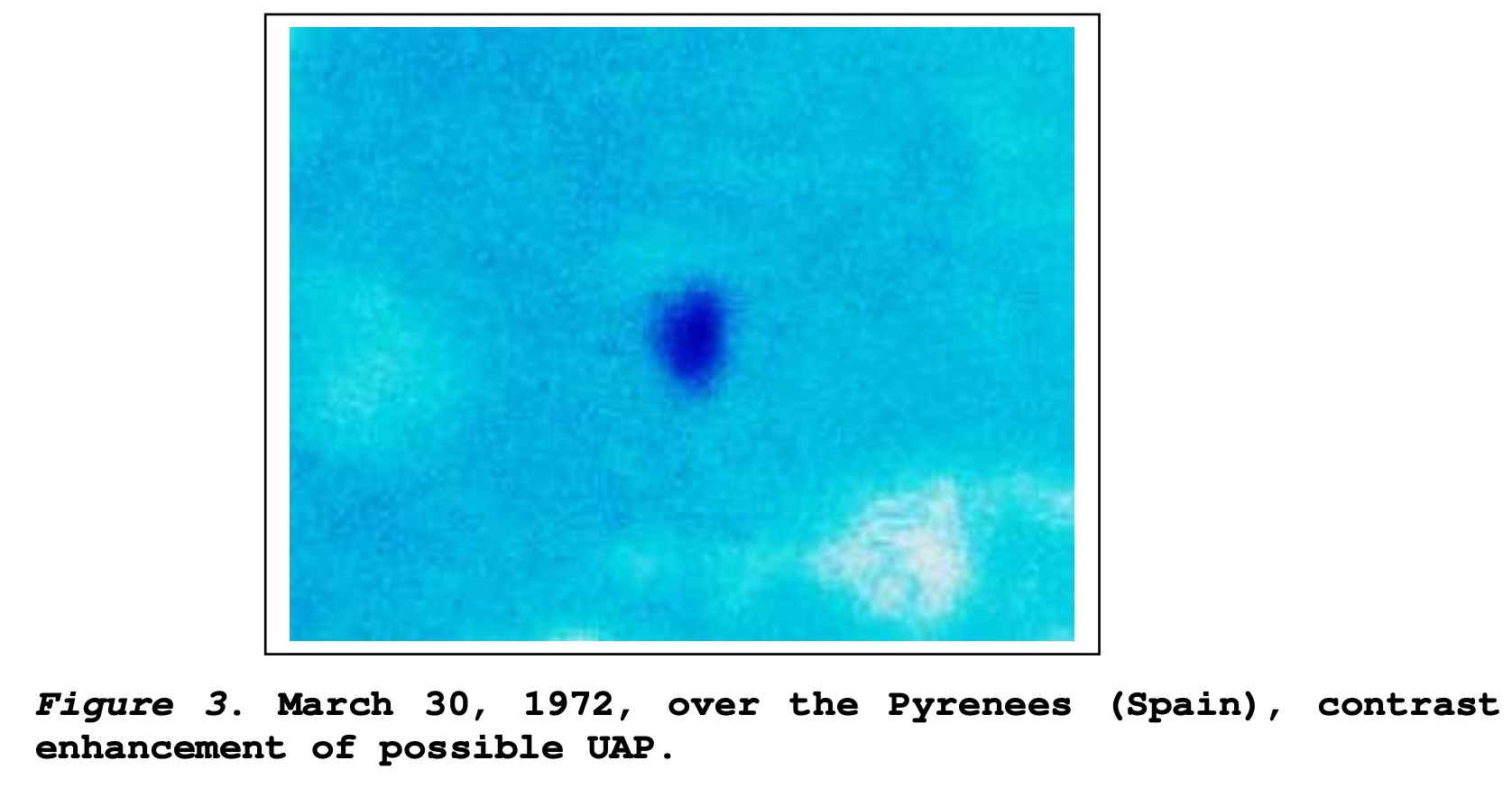
We have reviewed the major UAP database in Spain (2) and did not discover any UAP observation reported in that region in that timeframe. Also, French colleagues have been queried and no one recognizes any UAP sighting on the French side of the Pyrenees. Therefore, it is not possible to correlate this picture with any other aerial phenomenon seen by any local witness.
We do not even know if the photographer saw something unusual to photograph, or simply found it after the picture was developed. The fact that the UAP is not centered in the frame seems to indicate that it was a scenic shot where the object appeared later. About all we can say with confidence is that at the plane's altitude (evidently several times the height of the Pyrenees, so probably >30,000 ft, or >9,000 m) it was definitely not an insect and highly unlikely to be a bird. Whether it is a development flaw, an out-of-focus speck on the window glass, a floating balloon, or a true UAP, we cannot judge in the absence of a witness report. In truth it has the appearance of being a casual photo of nice scenery where something strange or unexpected has been noticed after processing.
Blessed with a total lack of information, we were even uncertain whether the white band in the picture was cloud or snow over mountain peaks. Opinions secured in a forum specialized in meteorology concluded that most of it is a bank of “daily clouds” formed by the evaporation and sublimation due to irradiation over the snowy surface below (3). In fact, an equalization of the original picture delineates in red the area of clouds, the rest being undulating snowy peaks.
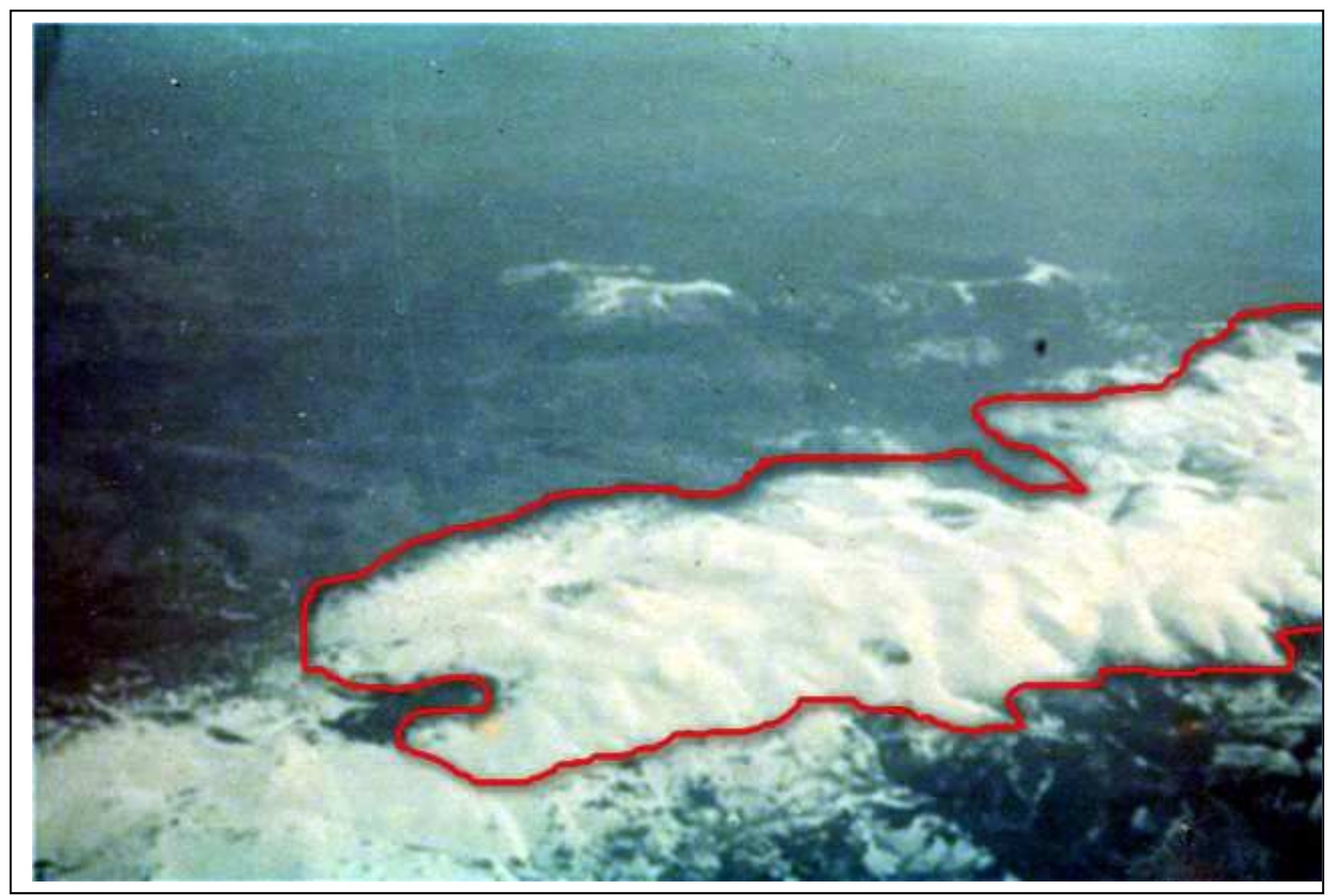

In the equalized photograph (Fig.4), made to maximize the contrast of the image, we also discover what seem to be several photographic artifacts. Two yellowish-colored, globe-shaped translucent bodies are embedded into the white band of clouds. One is placed around “ten o’clock” (left-hand side) and the other at “two o’clock” (right-hand side). There is another, dark red one below (SE) the second one. To us, these look very much like emulsion defects, or chemical staining. It would be funny if the true UAPs were these round, yellow-pink insubstantial-seeming “objects”, one of which is at the tag end (or prolongation) of a long-curved line starting from the upper extreme of the frame, which seems just a scratch to us. These “mysteries” of the slide will probably never be resolved unless the photographer stands up.
Case #2
Date: March 7, 1973 Time: 15:20 Location: Coronda, Santa Fe (Argentina) Cameraperson: Luis Hoffmann Mode: Slide
Page 204 of a 1978 book in Spanish devoted to UAP photographs authored by Argentinean researcher Guillermo Roncoroni and consultant Gustavo Álvarez (1) contains a short but interesting account. Not really a sphere but an ovoid shaped UAP, here included because it seems to us to be quite a bona fide document. Duly translated, this is the brief report published in the book:

“Luis Hoffmann obtained this photograph from his Cessna C 130 (there seems to be no such model, though there are 120 and 140 and many others; just a slip by the witness?) on March 7, 1973 at 15:20 hours while he was flying in route to the Buenos Aires airport. According to his narration, he was flying at some 1,500 ft (457 m) following the course of the Paraná river when, at the height of the town of Coronda, he sighted an ovoid object, white in color, moving to the west and, judging by the position of its shadow, very close to the ground. Luis Hoffmann was able to take two photographs of the object before it moved away at great speed into the Santa Fe province. The observation of pilot Hoffmann was corroborated by several witnesses from Diamante city, in the neighboring province of Entre Ríos, who several minutes before 15:30 hours affirm having sighted an object of similar features to the one photographed, shifting towards the west. According to our calculations –Roncoroni and Alvarez ́s estimate-, the object in question would have some 4 to 5 m long and 2 to 3 m diameter or thickness”. So much for the available information.
The Buenos Aires airport of Ezeiza is located ~383 km southeast of Coronda, so 145o would be the average flight heading of the airplane, though with large deviations if it was 'following the course' of the twisting Paraná River. Coronda is a town located some 27.5 km west-northwest (~295o) of the city of Diamante that lies on the border of the provinces of Santa Fe and Entre Ríos. Any object flying west from Diamante would be approximately on the path toward Coronda. We have prepared a map to show the local geography.
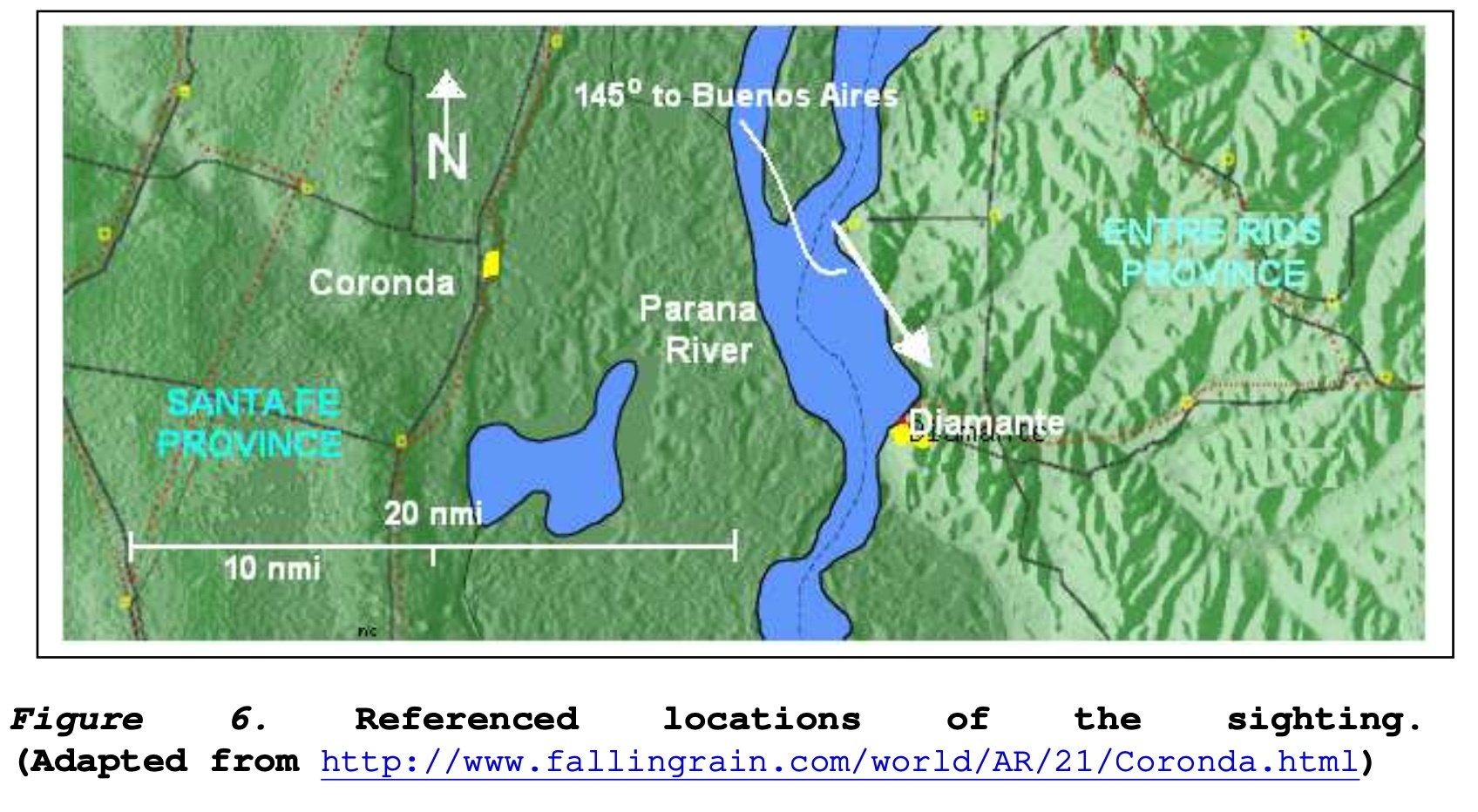
Unfortunately, in spite of having contacted many colleagues from Argentina, no-one has been able to contribute any additional information on this case. Neither could we find any press clippings or any other information confirming the UAP sightings from Diamante city.
The tale issued by the book authors mentions a shadow seen on the terrain. Yes, there is a shadow which at first sight appears as though it might be cast by the white oblong blob in the picture, roughly in the right position considering the sun’s azimuth at that time, but it could also be the shadow of a tree hidden by the blob.
The examination of the second photograph would eliminate our doubts, but only one photograph was published in the reference book. We have this in slide form from the collection of transparencies of Guillermo Roncoroni (see prior case) and we have not found any trace of picture number 2.
The Paraná river whose course the plane was following forms the east boundary of Santa Fe province. The broad smooth reddish area bordered by trees on the right of the photo is presumably the river water which often appears a muddy brown in satellite images (the color balance of the slide may also have been altered by deterioration of the emulsion dyes during the 36 years since it was exposed). Thus, if the plane is heading generally towards Buenos Aires along the Paraná River, we would expect that what we are seeing is the east bank of the Paraná
from a position just inside the neighboring province of Entre Ríos.
From a position ~32oS 61oW at 15:20 on March 7, 1973 the sun is at ~51o elevation and 306o azimuth, so that the direction of the shadows cast by the trees indicates that south should be at the top of the frame as we look at it, with Santa Fe province in the west on the right, beyond the river. These inferences are consistent with the report that the object flew away 'to the west...into the Santa Fe province'.
Roncoroni & Alvarez estimate a length of ~4.5 m for the major axis of the UAP assuming it to be a real object near the surface of the Earth. This figure is presumably based on an angular scale estimation. We do not have access to camera data that would permit a direct calculation of angular scale, but we can approximately check the internal consistency of this result.
From 457 m altitude a 4.5 m body near the surface not too far from the nadir subtends nearly 0.6o, which leads to an angular frame width of ~30o (a plausible value) and a linear FOV width on the ground of 225 m.
To the right of the frame can be seen a rough track winding among the trees, which looks too well-defined for a mere footpath and resembles a cart track or unmade road. Its true width can be scaled roughly by the nearby trees. These appear to be natural forestation whose spectrum of crown diameters therefore should have reached a stable equilibrium.
The average spread of similar trees in a forested area of the east bank of the Paraná near Coronda today is shown in the satellite photo in Fig.7 which is rendered at approximately the same linear scale. A forest track can be seen which varies in width between about 2 m and 3 m, and we estimate (crudely) that a typical crown spread of the maturer trees is in the region of 9 m.
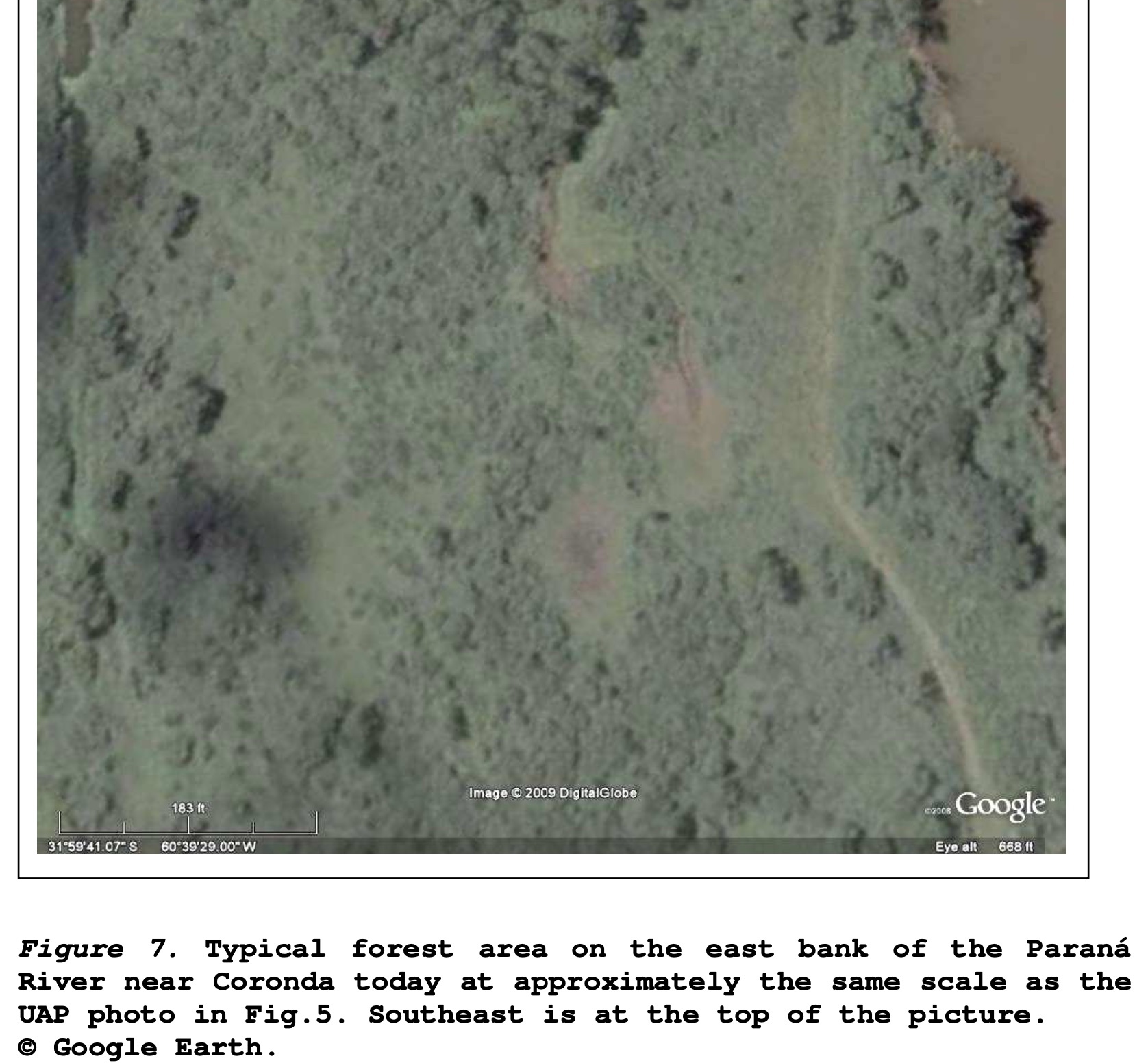
This latter figure would be consistent with a rule of thumb that height is comparable to canopy diameter for trees with a decurrent branching habit (i.e., a spreading, rounded crown rather than a pyramidal one). The dominant tree in the riverine forest of the Paraná basin is Tessaria integrifolia or the "River Alder" which spreads vigorously on the sand banks (4) with heights ranging from 3 to 10 m according to an Argentinean Environmental Atlas (5) or from 5 to 9 m according to another source (6) interspersed with Salix Humboldtiana, a willow that rises from 13 to 15 m. These figures suggest a typical average canopy height of more than 8 m, consistent with the estimated mature diameter of 9 m estimated above.
Transferring this measurement to the comparable trees in the UAP photo we can see that the UAP dimension inferred by Roncoroni & Alvarez is entirely plausible. This scale implies that the forest track shown there in 1973 is perhaps 2 m wide, which also seems reasonable.
A further rough cross-check is available because the ratio of height to shadow length equals the natural tangent of the solar elevation angle. If the tree dimensions estimated above are correct, then we judge that to a reasonable approximation the shadow of the tree to the right of the UAP probably indicates an elevation of ~45o±10o. This is consistent with the expected solar elevation of ~51o determined from date, time and map coordinates.
Finally, we note that the orientation of the major axis of the UAP is 40o-220o. If one assumes this axis to coincide with the direction of travel (this is to some degree an arbitrary assumption, but it would be the case for many types of object and might also be explained by motion blur; see below) then the direction of flight could be southwest across the river into Santa Fe, which can be interpreted as satisfying the general intent of the report.
There is a great deal of uncertain inference involved here, but nothing emerges that is inconsistent with the report details or that indicates unreliability in the presentation by Roncoroni & Alvarez.
The question remains: What might have caused the UAP to appear on the film?
Firstly, we considered the possibility that the photo shows elongation due to motion-blurring of an object that was more nearly circular in plan (i.e., a spheroid). For example, if the object was a true sphere traveling near the ground then the "time exposure" shows (assuming the inferred angular scale) a displacement of approximately 2 m during the time the shutter was open. We have no information on the exposure setting, but we can bracket a range of typical exposures between (say) 1/50 and 1/500 sec to yield true object speeds between 100 and 1000 m/sec, or ~200 knots and ~2,000 knots respectively.
The upper end of this range can probably be ruled out because the rapid angular rate of ~130o/sec would make it very difficult to visually observe and deliberately centre the UAP even for one photo before it sped away, and there appears to be no appreciable blurring of the background terrain due to camera jitter. To capture two photos in these conditions (as reported) would be effectively impossible. On the other hand, an angular rate near the lower end of the range, ~13o/sec, could reasonably permit two photographs of an object traveling near the ground at ~200 knots.
This is relative to the frame of reference of the moving aircraft, of course, whose groundspeed is probably close to half this value. Since a significant component of the aircraft vector is also likely to be parallel to the UAP vector on this hypothesis we can crudely-speaking say that the UAP ground speed would be in the region of 400 knots.
Note that a longer exposure than 1/50 sec reduces the required object speed but becomes impractical in terms of sharp photography from a moving light aircraft. 1/25 sec would imply an object airspeed in the order of 100 knots and we should regard this as a lower limit for the above scenario.
Of course, if the UAP were in fact only 100 m below the aircraft it might be a spheroid ~1 m in diameter and traveling at only ~20 knots (~40 km/h) relative to the frame of the aircraft. There is probably no calculable lower limit on this scenario. For an image in perfect focus a lower limit of size/speed would be reached when range from the camera reduces below the lens hyper focal distance. But in this case, it is not clear whether or not the UAP image is in optical focus (optical blur is of course separate and distinct from the motion blur we have been speculating about). For example, glare from a very bright optical emitter or specular reflector might be obscuring the true shape of the object, or a spherical plasma might not have a well-defined optical surface.
These considerations also bring in the question of the claimed ground shadow. Given the elevation of the sun, our opinion is that the supposed UAP shadow is so close to the UAP that a 3-dimensional ovoid casting it would have to be virtually tight on the ground. Yet there is evidence that if this were an object in linear flight to W or SW as reported it could not be hugging the ground. The expected elevation of 51o is close to the elevation (45o) that would produce a shadow of the same length as the height of a vertical rod. Adopting this approximation, we infer that the tree immediately abutting the UAP is in the region of 5 m tall, and clearly a UAP flying below this height in any direction near the reported one would be bound to impact the tree. Therefore, the UAP altitude would have to be >5 m, but this is grossly inconsistent with the position of its supposed shadow.
Also, the length and shape of the shadow does not seem quite right, and near the top right-hand end of the UAP it falls a little short of where it should lie considering the illumination angle (see Fig.8).
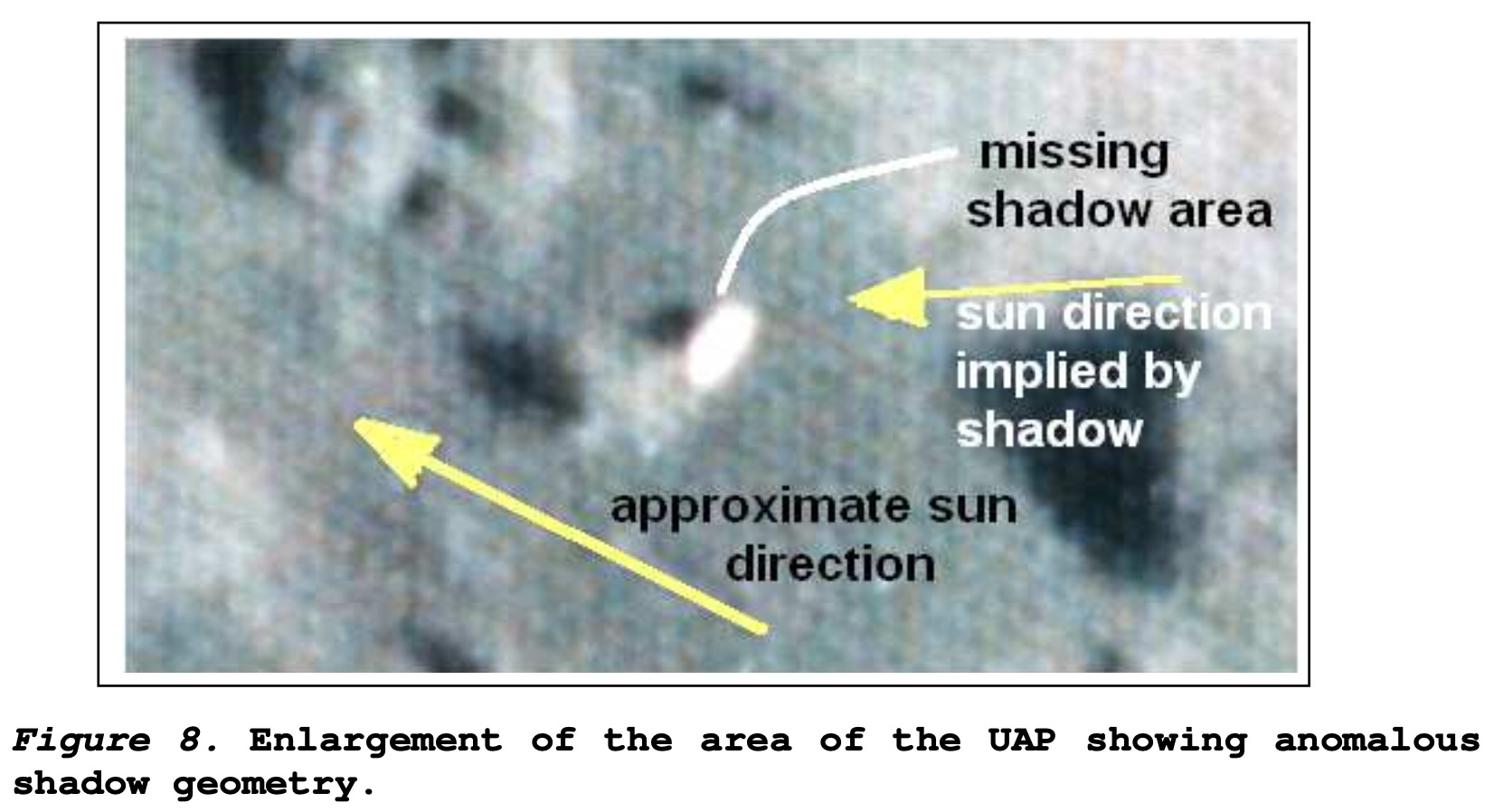
The UAP appears very bright. Densitometry on the original slide would be useful to confirm this, but our impression is that the UAP is as bright as or brighter than the whitest areas elsewhere in the frame, which are parts of the forest footpath, presumably pale soil or sand. This could be interpreted as indicating a true image of an object that is white or even luminous. Alternatively, it might indicate an emulsion or processing defect.
Examination of a large digital file reveals a regular granular texture which is not a 35 mm emulsion grain but appears more like a halftone screen pattern (see Fig.8). We wonder if the slide is a re-photograph of a print made by 4- colour litho or letterpress process. In this case the UAP could be an accidental artifact -or a deliberate one- introduced at several possible points during the original reproduction or secondary recopying stages and no meaningful discussion would be possible.
The implications of a likely developing failure would leave the photographer’s testimony in a bad place, of course. Unfortunately, no-one else has any alternative or complementary report from the witness and the alleged second photograph has never been seen. These facts are not encouraging for any attempt to refute the reasoning above.
Case #3
Date: 1996 (no more precise date known)
Time: not known (daylight)
Location: Somewhere from New York City, New York to Orlando, Florida (United States of America)
Cameraperson: not known
Mode: Photograph (digital image from internet)
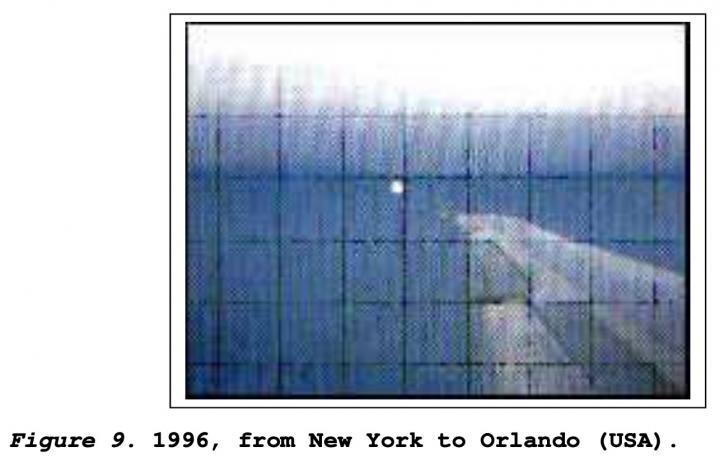
This image was found in the web site of Shadow Research,
Inc., an organization said to exist since 1995, which staff is not identified by name except for an electronic mail address (admin@shadowresearch.com). The following postal address is provided: P.O.Box 88, Algonac, Missouri 48001, USA.
In the “Photographs” section of the site the picture below is placed with a single line information back-up, as follows:
“The ...photograph shows a sphere off the wing of an aircraft on it’s (sic) way to Orlando from New York. 1996”. The image size is hardly 6.72 KB and a grid has been superimposed on the picture for an unknown reason, probably to produce a better effect in the viewer.
Even if the source describes it as a sphere, the dramatically low resolution of the photograph does not allow discerning the light’s real shape.
Assuming the original image to be genuine, we can observe a dark edge about 2/3 of the way up the frame, just above the aircraft's wingtip, which could be the terrestrial horizon. The plane is said to have been en route from New York to Orlando, which would place the sea off the left wing of the aircraft. The visible control surfaces indicate that the wing shown is the plane's left wing, and the photo would appear to have been taken not by flight deck crew but from a passenger window behind the wing. The "horizon" looks level, and the dark surface below is featureless enough to be the sea, so this much is consistent.
However, whilst the caption claims that the UAP is a "sphere" there is no way to justify this claim. Enlarging the jpeg reveals no more than that the source is contained approximately within a square of 4x4 pixels and could have any real geometry. If the claim comes from a witness report then we have no information about it, and even so one would have to object that discriminating sphericity from circularity in a distant light source is probably beyond the perceptual ability of the human eye.
Moreover, the dark "sea" could also be tarmac with the aircraft at rest or taxiing, or even the top of a very smooth cloud deck such as a stratus layer. Given this uncertainty, the UAP could be a light (if it is really a "light") above a cloud deck, a light above the sea, a light on the sea surface, or a light on the ground. Clearly each of these possibilities invites several trivial explanations which are impossible to rule out, for example: aircraft landing lights; a lighted ship or oil rig; a light on an airfield.
One site (7) lists 18 carriers presently operating on NY- Orlando using a variety of aircraft. We selected two aircraft types likely to have been used in 1996, the relatively small Dash-8 and the larger Boeing 757. Measuring the approximate wing-tip width from plan views and estimating the distance from cabin to wingtip gives two pairs of approximate values, 1 m at 12 m and 1.2 m at 16 m, which yield angular widths of about 4.5o and 5.0o respectively. These rough brackets are probably representative of a range of other aircraft wings. This leads to an angular diameter for the UAP image of approximately 0.8o to 0.9o, possibly approaching twice the apparent size of the moon.
But it isn't possible to say that this represents a true angular size because of unquantifiable factors -optical ones like glare and diffusion, and digital factors like pixel bleed and jpeg compression. The area of visual luminosity -if there was a visual- may have appeared much smaller, and the true size of the emitting object -if there was an object- may have been smaller still. Therefore, extremely generous upper limits on possible size of a light source at arbitrary ranges of 50, 500 and 5,000 m would be about 0.7 m, 7 m and 70 m respectively, and correcting for the unknowns mentioned above could conceivably reduce these figures by as much as a factor 10. So, this exercise suggests an angular diameter consistent with a wide range of hypotheses, including several of those mentioned above.
In short, there are several possible explanations and it isn't even possible to say with certainty that it *is* a true photograph, so poor is the quality.
We have contacted (early August 2009) the source requesting further information or any means to locate the photographer. But no response has been obtained.
Case #4
Date: July 17, 1997 Time: 11:00 Location: Over the Tehuantepeque Isthmus (Mexico) Cameraperson: Gerardo Eduardo Mendoza Palacios Mode: Photograph, analog (scanned picture)
There is a web site in Guatemala (http://www.siglo30.com/) which stands as the online support to the Spanish language radio program Siglo XXX (30th century), which has broadcast since 1973, according to the web page. The contact person is Mr. Gerardo Eduardo Mendoza Palacios who signs many of the site’s texts and appears as general director of Siglo XXX. It was here that we found this photograph some time ago. Later on, the link to it was lost during a web format readjustment, but we had already saved the images and the related brief information.
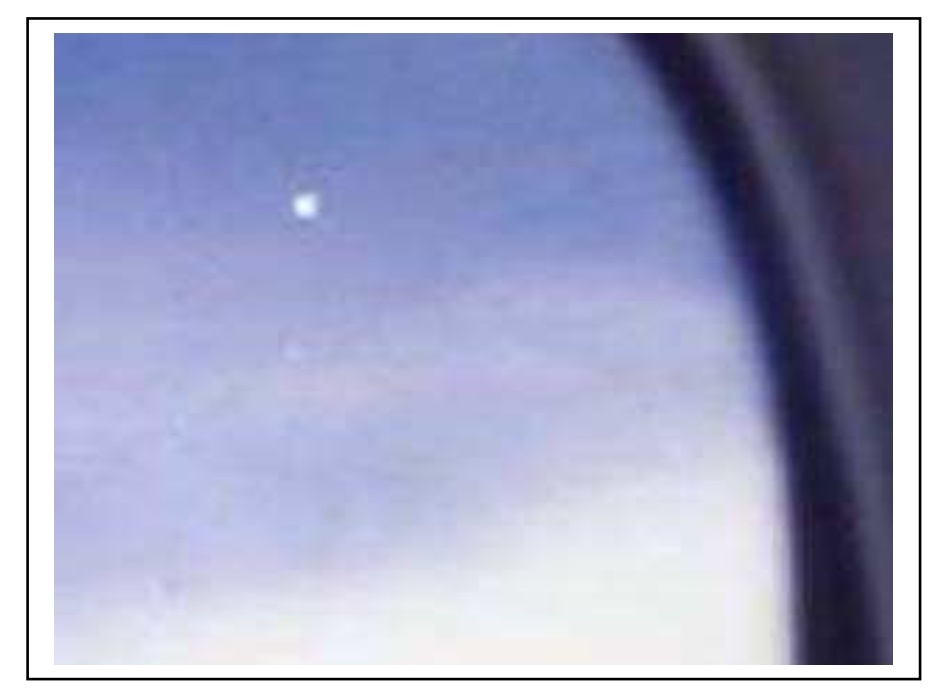

The short information initially provided by the source follows:
“This photograph was taken aboard a Jumbo 747 commercial airplane. The dot attracted the attention of several passengers because it did not look like another airplane due to the intense light it produced, to the point that one of the members of the S.C. family (see below, for real identity) said: It was as if it was self-luminous and the light emanated from the very object”.
The caption in the web page claimed that the blow-up shows it not to be round and besides that the digital camera flash was not used, to deny it was a reflection. The site also reported that when the image was inspected through the computer three or four luminous, weaker dots were observed. The photograph was submitted to the web site by someone only identified as L.M. (Initials were used to hide the identities of witnesses).
The main picture shows the KLM logo of the Royal Dutch Airlines and the wing geometry, engines, winglet etc positively identify the aircraft as a Boeing 747. We have checked out that Boeing 747 was the type of aircraft used by this company to fly South American routes (8).
Once again in this case lacking the basic data needed for a proper analysis, a request was submitted to the source for additional information. A series of questions were raised and from received responses the following detailed narrative could be built.
The informant, Eduardo Mendoza (54 years of age), was on a flight from Guatemala City to Mexico, D.F., with his now ex- wife (O.S.C.) and her 17-year-old daughter (A.L.M.S.), this one being the main eyewitness. It was the youngster, sitting beside the window, who suddenly noticed some “lights or reflections” outside the cabin and alerted Mendoza. It was around 11 a.m., at the mid-point of the route between the international airports of La Aurora (Guatemala) and Beníto Juárez (México, D.F.) and the flight status screen informed them that the airplane was over flying the Isthmus of Tehuantepeque (Mexico), at an altitude of 36,000 ft (11,000 m). It was Mr. Mendoza himself who took two photographs, looking east, the first one showing the main light located at “four o’clock” as well as another showing big cumulus clouds and two other secondary white dots placed at “two o’clock”, hard to distinguish in the reproduction. No flash was used, as can be confirmed by inspection of the border of the windowpane, and the camera used was a domestic analog Cannon, with ASA 100 film. It had no zoom. The actual pictures were scanned for online usage. The photographer stated that he had misplaced the original negatives, “among many that I have”.
The duration of the sighting was around one minute, then the lights disappeared because of the changing position either of the airplane or of the clouds. The lights were apparently moving very slowly in an opposite direction to the aircraft course. The photographer’s guess is that, because the lights were at an altitude “parallel to the airplane”, these were not at sea level. He specifically commented: “I have traveled this route tens of times and I can identify (especially in the night) the gas exhausts from the oil rigs in the Gulf of Mexico” (9).
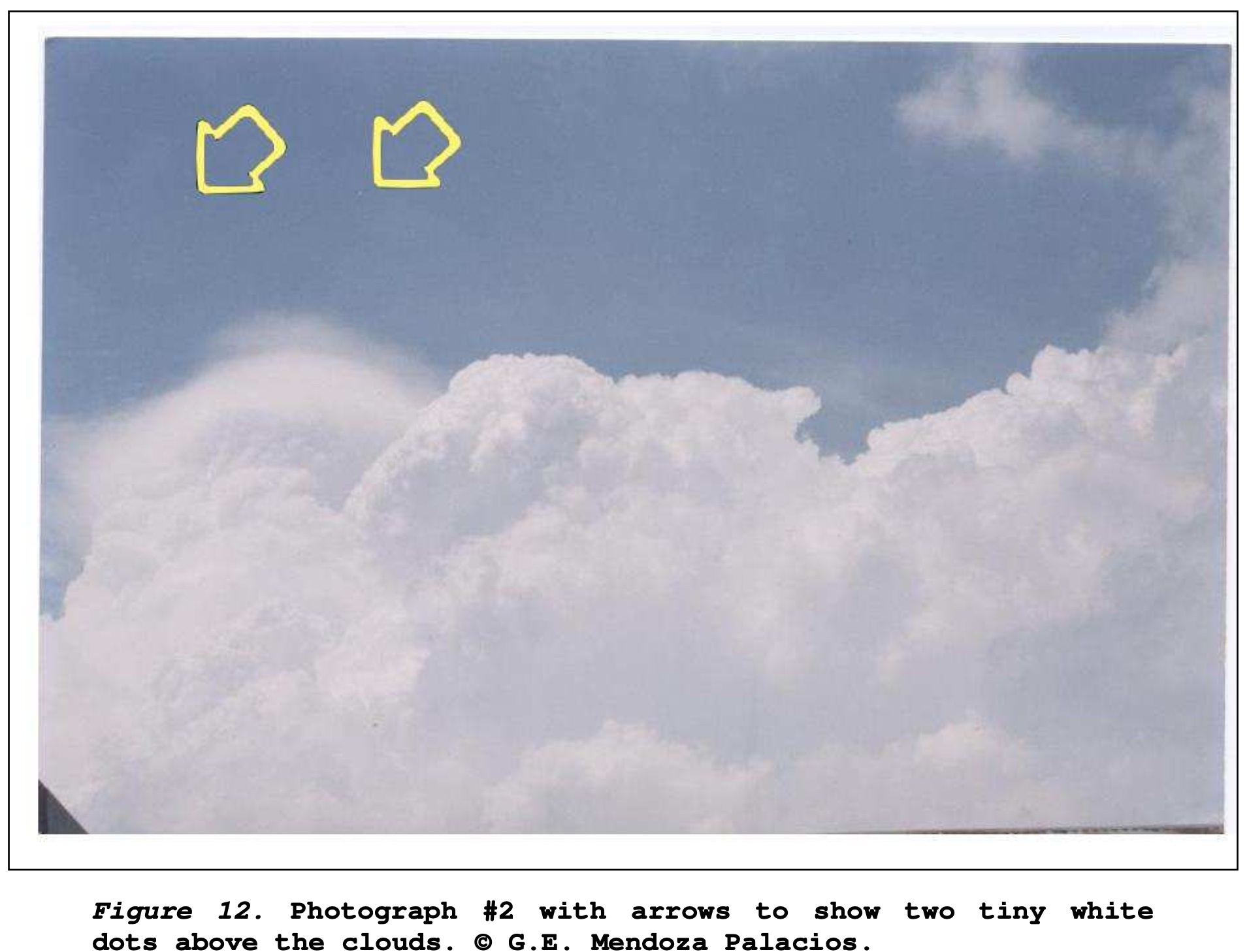
As these two UAPs are practically invisible to the naked eye in the reproduction (scanned from a print), we have
produced Fig. 13 with an enlarged (3x) and contrast-enhanced picture.
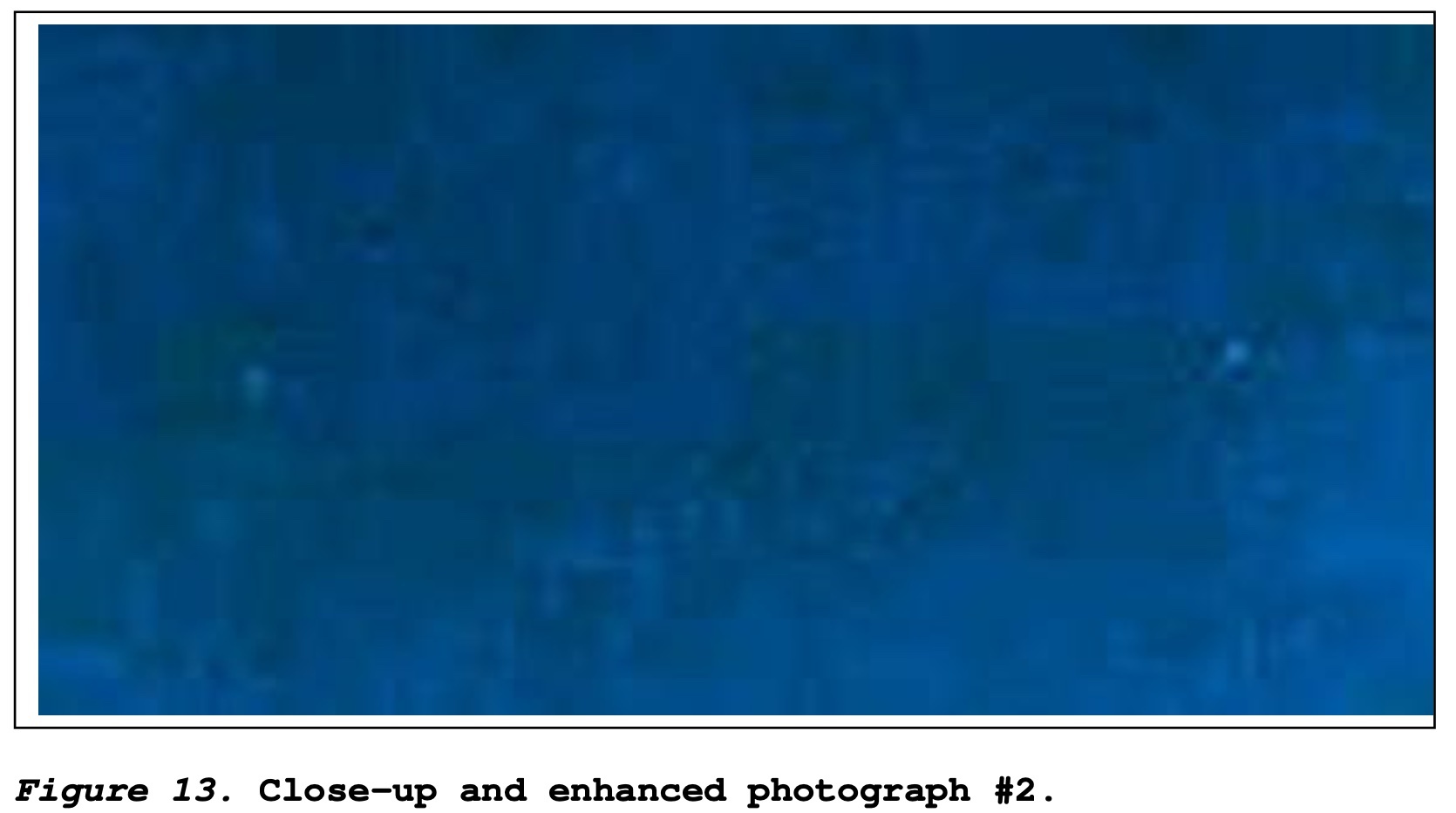
The sequence of events was as follows: the young girl (window seat) sees the main light “or reflection from something”, she tells her parents and her father (sitting in the aisle seat) position himself to take the first photo (Fig.10). The mother was in the center seat (unsure if she saw it). Then the girl sees the pair of dim lights and Mr. Mendoza, again, takes the second photo (Fig.12), without actually seeing the lights, hoping to be able to snap them successfully. Some 30 sec elapsed between one photo and the next. After taking the second photo the main light was not seen anymore: “The truth is that it did not last long before I could sit down again, and my daughter got accommodated in her seat. We thought that in this lapse of time and due to the speed of the aircraft we had left the light behind the angle of the window”, Mr. Mendoza told us. The three lights never were seen simultaneously. According to the girl (the principal visual witness), both the source visible in Fig.10 and the two faint sources in Fig.12 “were as they looked in the pictures”. In view of the difficulty of saying anything meaningful about the image in Fig.12, the following discussion focuses on the image of main light (Fig.10).
From plans of the Boeing 747 (10) we measured the approximate distance from the camera position forward of the right-hand wing to the winglet on the wingtip, which is 128 ft (40 m). The width of the winglet was measured at approximately 7.7 ft (2.4 m) at the root. The angular width of the winglet is therefore ~3.5o, enabling us to measure the angular diameter of the UAP as lying in the range 0.3o to 0.6o (it is not possible to identify a perfectly sharp edge), a diameter comparable to the full moon.
Enlargement shows that the source is correct to state that the UAP image is not quite perfectly circular.
The line of sight (LOS) to the UAP is rotated backwards from the camera position, at an angle close to 135o from the aircraft's forward centerline, and the FOV contains both the near and far edges of a window frame whose near edge is inside the lens hyper focal distance and significantly blurred. The angle of the LOS intercepts the plane of the window glass at ~45o. This rules out the possibility of a reflection from a LED status light on the camera (such lights are commonly red in any case) or from other sources close to the photographer.
However, the angle of photography indicates that the window must be adjacent to a seat row behind the camera position. At the bottom center of the frame we find what appears to be a reflection in the window glass of a light- colored interior object partially overlapping the shadowed engine nacelle. We suspect other interior reflections higher in the image, merging with the clouds, reflections which are hard to identify but could be from light areas of the seat immediately behind the photographer or from the clothing of a passenger occupying this seat.
Considering the photograph in isolation from the personal testimony for the moment, this suggests the possibility that the "UAP" could also be a secondary window reflection from a nearby interior cabin source.
A possible primary source would be a specular reflection in, say, a spectacle lens, a camera lens or shiny jewellery. Inspection of the light and shadow on the window frame appears to confirm the correctness of the source's statement that no camera flash was used; therefore, the obvious source of a specular reflection would be the sun. To investigate this, we looked at the sun angle.
On the outboard engine pod, we can clearly identify the shadow of the point on the wing leading edge where the pylon is attached (at the "hip" where the leading-edge sweep changes by a couple of degrees). Dropping a line to the shadow indicates that the sun was high, at a zenith angle of approximately 40o (or strictly speaking at an elevation of 50o relative to the local horizontal defined by the fore-aft aircraft axis) and on a bearing roughly behind the plane, several degrees to starboard of the aircraft centerline. This latter angle may be larger than it appears to the eye because the outboard 747 engine pod is itself "toed-in" towards the centerline by about 2o. Nevertheless, it seems unlikely that the sun would have been in a position to directly illuminate a specular reflector in the cabin position implied. Whether indirect scattered light from the clouds would be sufficient to cause such a reflection seems doubtful.
It remains possible, if not very probable, that it is a reflection of some other interior light source, such as an electric reading lamp or similar. But, in general, reflection theories are unattractive if the report information is trustworthy and if several people viewed the UAP with the naked eye at the time.
Turning then to other explanations, we determined above that the principal UAP (Fig.10) has approximately the angular diameter of the full moon. Could it be the moon, perhaps blurred by a thin cirrus haze? The UAP appears almost circular, and the phase of the moon around the sighting date was very nearly full, 94%.
This seems unlikely for several reasons: the likely altitude of the sun suggests full daylight and the intrinsic brightness of the moon would be insufficient. Regardless of the true time of day, a nearly full moon requires that the UAP should make an angle with the sun approaching 180o, yet the angle between the UAP and the sun determined from the shadow on the aircraft engine pod is only around 90o. And finally, if the reported date and location are approximately correct the moon is ruled out because the moon set a couple of hours before sunrise and remained below the Earth until early evening.
Venus can sometimes be seen in daylight when near maximum brightness, although around this date it was far from maximum brightness (magnitude -2.7). In this region it rose at about 9:30-10:00am local time in the ENE on the sighting date and would have been low in the sky to the right of an aircraft heading NW from Guatemala into Mexico on the morning of July 17, 1997, consistent with the photo. However, Venus was only ~27o from the sun, and therefore is fairly conclusively ruled out by the shadow angle indicating that the UAP is nearly 90o away from the sun.
We note that the sun's bearing and high elevation is not inconsistent with cruise on a heading roughly NW during the morning in the summer at a low northern latitude, which would fit the journey reported from Guatemala to Mexico. From the reported location (11,000 m above the Isthmus of Tehuantepeque), the Bay of Campeche would lie to the right of the aircraft, and it is conceivable that it could be near enough -within perhaps a few tens of miles- for oil rig burn- off flares in the Bay to be visible (11). The source notes that other fainter lights are visible on the original (though these are not very evident on the jpeg available), conceivably indicating a group of flares in this busy oilfield. This theory would imply that the blue background is the ocean and that the plane is banking to the right, which in turn would strongly strengthen the inference from the shadow angle that this was a morning flight.
However, information provided by the photographer appears to rule this out. In response to other questions he indicated without being prompted that he was a frequent flyer on this route and was very familiar with the oil-field flares (at night, at least), adding that the photographed lights were in his opinion well above the sea horizon and appeared level with the aircraft.
Another, possibly more plausible, theory is that the photo shows the landing lights of another jet, heading almost directly towards the camera. Landing lights are very powerful and might be seen from miles away even in daylight. It might be objected that landing lights are only for night operation, but this is not the case. It seems there are differing conventions and few international regulations about this (12), but many operators, pilots and aviation authorities in many countries make it standard practice to require landing lights during daylight to enhance visibility and reduce collision risk either when below a certain height (say 10,000 ft or 3,000 m), when within 10 miles (some 20 km) of a runway, when in any Terminal Maneuvering Area, when in reduced visibility, when in busy airspace en route, or in some cases all the time.
In summary, whilst this photo is not without potential interest it is impossible to evaluate confidently on the basis of the limited information available.
Fortsetzung: Die Jagd nach Sphären in Bildern Teil-2


